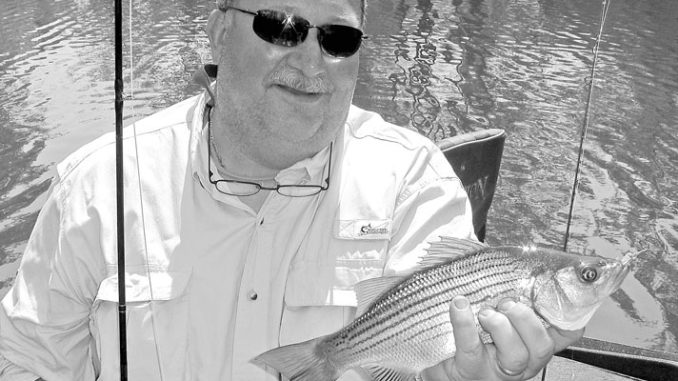
Here on the northern Gulf Coast, we’re enjoying one of the best runs of white trout and chicken dolphin in many years.
You might think these two diverse species have only one thing in common — that saltwater passes through their gills. Au contrare, Robespierre!
White trout and dolphin are like the James Deans of the piscatorial world: They grow fast, live hard, and die young. A dorado is eligible to join A.A.R.P. by the time he’s 4 years old. A white trout, even younger, at age 3.
They also share a fondness for flies.
In the lexicon of our sport, the term “fly friendly” is seldom used, but is of great importance. A fly-friendly species is one, that under the right conditions, is just as likely, or more likely, to eat a fly as to any other lure or bait.
As a baseline, any species of fish can be caught on fly rod. Take catfish and sheepshead, for example.
Many of my colleagues have been quite successful in catching cats on the fly at Lakes St. John, Concordia, False River and Verret. It’s always an incidental catch while fishing for bass or bream. Cats seem to really like a black/chartreuse jitterbee suspended 3 feet under a strike indicator. Using this setup, I once managed 11 channel cats between 3 and 8 pounds on St. John.
These lakes have green-clear water and loads of catfish. Having clear water favors the odds of catching any fish on fly. Having plenty of one particular predator creates competition for food, which also helps favor flies.
Sheepshead are a difficult and exasperating fish to catch on fly, because they are such finicky feeders. It’s earned them the nickname “Cajun Permit,” after one of the most challenging species in all of fly fishing.
Still, with excellent casting skills, loads of patience, and the right fly — a small Charlie with a marabou wing works great — one can have a good day catching “goats” on fly rod in the Louisiana marsh.
But make no mistake — catfish and sheepshead do not pass my BFF (Best Friends Forever) test when it comes to flies. However many you might catch on some artificial, you would’ve done a lot better using bait.
Bluegill is a different story. On countless trips, I’ve come back to the launch with a nice mess of bream, and then learned that I’d outcaught most of the worm and cricket anglers.
Back when Bonaventures on False River was still open, I’d work the bank and docks in the afternoons after work and pull out beaucoup bluegill and chiquapin (redear) each trip. The folks using bait didn’t mind, but the guy selling the bait kept giving me the evil eye!
Can you think of other fly-friendly fish?
The one that is universally considered is salmonids — rainbow trout, browns, brookies and cutthroats. However, wild trout and hatchery stockers are completely different. Fresh stockers are like small pigs; they’ll eat anything. Wild trout will never lower themselves to eating corn or marshmallows.
Bream, spotted bass, white bass, chain pickerel and Rio Grande perch are the most fly-friendly species that swim in Louisiana fresh waters. Depending on the environment, flies — especially poppers — can be as effective on largemouth bass as any lure.
In salt, the list includes white trout, speckled trout, redfish, dolphin, flounder, Spanish and king mackerel and bluefish, to name a few.
Why is passing the BFF Test important?
At some point during the year, every species is in dormant or passive mode. They become difficult to catch on any lure, much less flies. Having another species take up the slack not only gives us reason to continue fishing, but expands our horizons.
In late summer, specks and reds slow down. At the same time, it’s the peak for white trout, Spanish, kings, bluefish and tripletail.
White trout feed aggressively on shrimp and bay anchovies (silversides). Note the word “aggressively” — that means anything even close to a shrimp or anchovy gets devoured. Just let a weighted crystal shrimp or Clouser minnow get to the bottom, then strip in.
Spanish are a hoot on flyrod. The “El Diablo” loves Clouser minnows. Clousers need to be stripped in very fast — skirted on the surface of the water drives the most strikes. One popular technique is to place the rod under one arm, and use both hands to strip the fly in.
During late summer, Spanish will invade the inside waters. Catching them from a kayak or off rock jetties requires practice in line management. Anything that catches fly line — even for an instant — will result in a breakoff as the Diablo clocks it to high speed.
Small kings will venture close to shore. In most cases, I’ve hit them boat fishing a few hundreds yards off the beach. However, on two occasions I’ve hooked up while surf fishing.
Better have a metal wire bite tippet and a really good disc drag reel with lots of backing. In an instant, I’ve had my entire line stripped off, then watched as the king leaped into the air some 30 degrees from the direction my backing was heading!
The fly-friendly factor works in winter also.
At a time when bream and bass are slow, chain pickerel are most active. Like their cousins the pike, they love Seaducers! Find some real quiet backwater, and toss a red/white Seaducer along a weedline or fallen timber, then hold on.
In South Louisiana, choupique (bowfin) are more common than pickerel. They too pass the BFF Test. Deceivers work a little better than Seaducers, but it doesn’t hurt to try both.
Oddly, there are many fly-friendly species that have no or few listings on the Louisiana Outdoor Writers Association Fly Fish Division records. Set a goal for the remainder of 2011 to target one of these open species and get your fish on the books.


